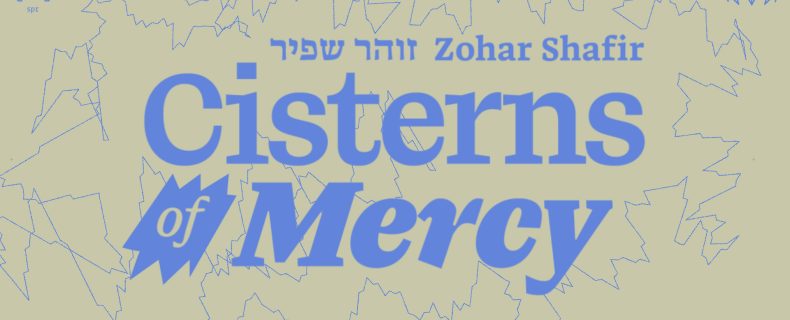Cisterns of Mercy

Cisterns of Mercy
זוהר שפיר (Nico Teen)
13:10 דקות
17.05.24– 15.08.24
פתיחה (ללא אירוע): שישי, 17.05.24, 11:00
אירוע בתערוכה: חמישי, 6.6, 19:30
ביצירה הקולית Cisterns of Mercy זוהר שפיר בוחנת את שרידותו של העולם הפנימי אל מול מכבש המציאות, העולם הפנימי שמחפש אפשרויות קיום כשהכול חדל. לדברי שפיר, ״ההיגיון אִכזב שוב ולכן נפנה לו עורף ונצעד עמוק יותר לעולם פנימה״. העבודה נעה בין טקסטים אבסטרקטיים חלומיים ופראזות מעולם הפּוֹפּ לבין טקסט אינטימי ישיר וקונקרטי. ״המילה [היא] כמו רדיו אשר משדר מעולם אחר״, כותבת שפיר, ובכך מאפיינת את המוטיב העיקרי של היצירה: ניסיון לגשר בין העולם הפנימי להווה.
המקהלה שמבצעת את היצירה הוקמה במיוחד לשם כך. שפיר שמה דגש על חקר הקולות השונים של חברות המקהלה ומחפשת את האינטונציה והגוון הקולי הייחודיים של כל אחת מהן בהתייחס לטקסט ולמוזיקה. דרך שימוש בטכניקה של דקלום טקסט יחד וחזרה על פראזות שירה, השוני הקולי הבלתי נשלט של חברות המקהלה נחשף ומאפשר הצצה וביטוי לטביעת האצבע הקולית והאישית שלהן.
היצירה בנויה מחומרים שהוקלטו עם המקהלה ונערכו בדרכים שונות, המורכבים מחדש לסוג של מונטאז׳ קולי. בעבודת העריכה שפיר משתמשת בבידוד הקולות, הרכבת הקלטות שונות של אותו השיר זו על זו, ערבוב בין הקלטות טקסט לקטעי שירה אינסטרומנטליים ושימוש באיכויות הקלטה שונות המבדילות בין היצירות בעבודה. פירוק החומרים מדגיש את החוויה האסוציאטיבית של היצירה ואת התנועה בין האבסטרקטי, הקומי והאינטימי.
היצירה מורכבת מארבעה פרקים ובהם מיזנסצנות קטנות המשלבות טקסטים מוקראים ושירים קצרים. השירים בעבודה מושפעים ממוזיקה פופולרית, המאופיינת בשימוש ב-hooks, בחזרתיות ובדימויים פופולריים. עם זאת, שפיר חותרת לשבש את המבנה המסורתי של השיר, להשאיר את האלמנטים הפּוֹפּיים פרומים, תלויים באוויר, לא גמורים. השירים הקצרים מרפררים לסגנונות מוכרים בתרבות הפופולרית – בלוז, רוק כבד וזמר עברי – אך כולם משובשים בדרך כלשהי.
את היצירה מלווה פנזין שיצרה שפיר, שכולל את הטקסטים של השירים, איורים ותחריט של האמן אורי ליפשיץ ז״ל בשם ״מגדת העתידות״.
מקהלה: זוהר שפיר, אור אלוני, איה ליאון, נעמה מוקדי, איילה שמיר, עדן שקד
אוצרות: אמיר בולצמן | הקלטה ומיקס: אורי קדישאי | מנהלת פרויקט: נעמה מוקדי | ניהול אמנותי גלריית בית התה: מרכז לאמנות ומחקר מעמותה בשיתוף עם בית הנסן, מרכז לעיצוב, מדיה וטכנולוגיה | עיצוב גרפי: ענת גוטברג
זוהר שפיר (1981) היא מוזיקאית ופרפורמרית העוסקת במרחבים שבין נוסטלגיה, דה-קונסטרוקציה ומוזיקה פופולרית. יצירתה כוללת הלחנה ועיבוד בעזרת טייפים, חומרי ארכיון וכלים אלקטרוניים. בצד פעילותה בתחום המוזיקה הניסיונית הוציאה לאור ארבעה אלבומים תחת השם ניקו טין. הן בשיתופי פעולה והן בפרויקט הסולו שלה שפיר עוסקת בפירוק והרכבה מחדש של מבנים המאפיינים מוזיקת פופ וחוקרת את המבע הקולי באמצעות טקסטים מקוריים, שאף הם עוסקים בשאלות על מוזיקה פופולרית ומושפעים ממנה.
שפיר היא בוגרת המחלקה למוזיקה חדשה במוסררה – ביה"ס הרב תחומי לאמנות וחברה ע"ש נגר. בשנים האחרונות היא מלמדת פיתוח קול בדגש על גוף ותנועה כאמצעי לשכלול המבע הקולי.
בית התה
בתחילת שנת 2021, לאחר שבית התה הוכרז על ידי עיריית ירושלים כאובייקט לשימור, הועבר מבנה בית התה מחצר וילה שרובר, שהייתה אחד הסמלים של שכונת טלביה היוקרתית, אל הגינה הצפונית של בית הנסן.
גלריית בית התה היא מרחב אמנותי ייחודי בנוף התרבות הישראלי, המציג באופן בלעדי עבודות סאונד. הגלריה היא מרחב האזנה לעבודות סאונד-ארט, קומפוזיציה ומוזיקה ניסיונית. בשנתיים האחרונות התארחו בגלריה מלחינים ומלחינות, אמנים ואמניות סאונד מקומיים ובין-לאומיים.
שעות פעילות גלריית בית התה:
ב׳–ה׳ 10:00–22:00
ו׳ 10:00–14:00
ביום חמישי, ה-6.6 ב-19:30 יתקיים שיח עם האמנית והאוצר על תהליך העבודה, והאזנה משותפת לעבודה.


